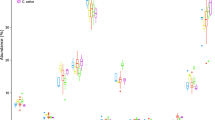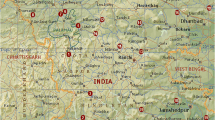Abstract
Significant genetic variation for lauric acid (12∶0) and capric acid (10∶0) composition and seed weight was measured within lauric acid-rich, self-pollinating germplasm accessions ofCuphea wrightii, C. tolucana, andC. lutea. Means and ranges of individual plant progenies for 12∶0 content ofC. wrightii accessions was 60.5±.63% (49.8±65.8%), 10∶0 content was 23.7±.54% (18.6±33.0%), and 1000-seed weight was 1.50±.03 g (1.20–2.47 g). Progenies of single plant selections carried to the S2 generation exhibited reduced variability within selections, but significant variation among selections for 12∶0, 10∶0 and 1000-seed weight. Variation among single plant selections ofC. tolucana was less than that ofC. wrightii and attributed to a restricted germplasm base. Means and ranges for 12∶0 content were 61.6±.47% (59.2–69.9%), 10∶0 was 22.3±.62% (11.7–25.3%), and 1000-seed weight was 1.40±.05 g (0.90–1.69 g).Cuphea lutea has a significantly different 12∶0−10∶0 profile than the other lauric acid-rich species. Means and ranges for 12∶0 were 36.8±.14% (33.7–40.8%), 10∶0 was 21.8±.08% (16.4–23.9%), 1000-seed weight was 2.26±.02 g (1.82–272 g). The 1000-seed weight was highly positively correlated with 8∶0, 10∶0, 18∶1 and 18∶2 contents and highly negatively correlated with 12∶0, 14∶0 and 16∶0 in bothC. wrightii andC. tolucana. No such relationship was found forC. lutea. A highly significant negative correlation was also measured for 12∶0 and 10∶0 contents inC. wrightii andC. tolucana.
Similar content being viewed by others
References
Arkcoll D.,Econ. Bot. 42:195 (1988).
Arndt, S.,J. Am. Oil Chem. Soc. 62:6 (1985).
Thompson, A.E. and R. Kleiman,65:139 (1988).
Babayan, V.K.,58:49A (1981).
Babayan, V.K.,Lipids 22:417 (1987).
Bach, A.C. and V.K. Babayan,Am. J. Clin. Nutr. 36:950 (1982).
Thompson, A.E.,HortScience 19:352 (1984).
Graham, S.A.,Crit. Rev. Food Sci. Nutr. 28:139 (1989).
Miller, R.W., F.R. Earle, I.A. Wolff and Q. Jones,J. Am. Oil Chem. Soc. 41:279 (1964).
Graham, S.A., F. Hirsinger and G. Röbbelen,Am. J. Bot. 68:908 (1981).
Wolf, R.B., S.A. Graham and R. Kleiman,J. Oil Chem. Soc. 60:27 (1983).
Graham, S.A. and R. Kleiman,62:81 (1985).
Hirsinger, F. and P.F. Knowles,Econ. Bot. 38:439 (1984).
Hirsinger, F.,J. Am. Oil Chem. Soc. 62:76 (1985).
Author information
Authors and Affiliations
About this article
Cite this article
Thompson, A.E., Dierig, D.A., Knapp, S.J. et al. Variation in fatty acid content and seed weight in some lauric acid richCuphea species. J Am Oil Chem Soc 67, 611–617 (1990). https://doi.org/10.1007/BF02540409
Received:
Accepted:
Issue Date:
DOI: https://doi.org/10.1007/BF02540409




